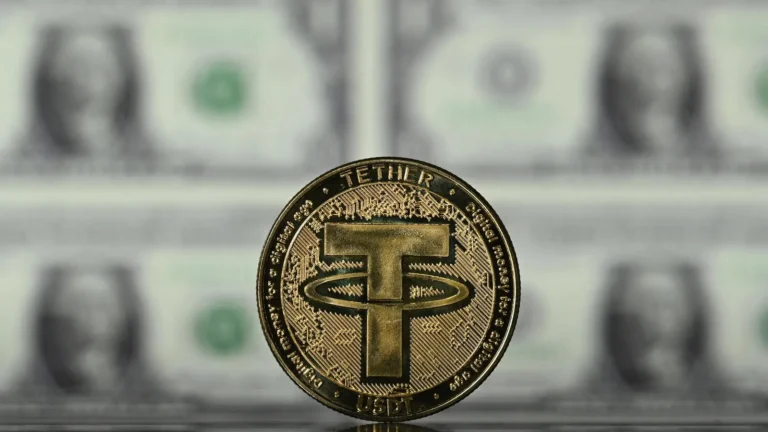USDT’s market capitalization exceeds $120 billion, demonstrating USDT’s growing dominance in stablecoins and global digital finance. Tether holds $118.4 billion in reserves, with $97.6 billion held in the U.S. Treasury, securing stablecoin issuance.
Tether’s USDT, the world’s largest stablecoin with a market capitalization of over $120 billion, is at a major turning point. This remarkable expansion not only highlights USDT’s dominance in the stablecoin market, but also highlights its essential importance in major crypto markets.
According to Lookonchain, Tron and Ethereum are the leading networks among several blockchains that spread the large-scale circulation of stablecoins. Tron currently has over 61.49 billion USDT (51.17%) in circulation, and Ethereum has 54.48 billion USDT (45.34%) in circulation.
of $USDT Market capitalization exceeds $120 billion!
The current distribution volume is $USDT It is 120.17B $USDTof which 61.49B $USDT(51.17%) are in circulation #Tron Network and 54.48B $USDT(45.34%) are in circulation #Ethereum.https://t.co/5Mzl43My0S pic.twitter.com/UUpm8FM4vC
— Lookonchain (@lookonchain) October 20, 2024
Rising demand for USDT highlights stablecoin’s important role in volatile markets
The rise in USDT’s market capitalization highlights the growing need for stablecoins as a safe haven amid crypto volatility. USDT provides traders and investors who want to store their assets in a less volatile asset with stability and liquidity, as the USD-linked stablecoin remains within the crypto ecosystem. The attractiveness of USDT has helped it grow exponentially, especially during times of market downturn.
According to recent estimates, USDT’s daily trading volume on Tron is $53 billion, higher than Visa’s average daily trading volume of $42 billion. This surprising success highlights how the financial landscape is changing and shows how digital currencies are becoming accepted in major transactions.
Tron’s low transaction fees and effective network efficiency have made it a popular blockchain for USDT remittances, establishing its leadership as Tether’s primary platform. Conversely, Ethereum was once the most frequently used chain for USDT, but slow transaction speeds and high gas fees have led to a decline in activity.
Expansion of stablecoin market increases liquidity and trading activity
There is no doubt that as USDT’s market cap continues to rise, its influence on the larger crypto market is increasing. An increase in the amount of USDT in circulation typically indicates increased liquidity, which can result in increased trading activity and influence price movements in large cryptocurrencies such as Bitcoin.
Increased supply of stablecoins has historically been associated with increased purchasing pressure, as investors typically hold on to stablecoins such as USDT before moving them into more volatile assets. Especially at a time when investor enthusiasm for cryptocurrencies is rising, this flood of funds could trigger a market rally.
Furthermore, supporting Tether’s dominance in the stablecoin industry is its wide range of applications across multiple blockchains. Tether holds over 70% of the stablecoin market share, and the overall market capitalization of these coins has grown significantly.
This degree of control raises serious questions regarding Tether’s impact on market liquidity and its role in maintaining stability in the cryptocurrency ecosystem.
However, this also comes with certain risks, as Tether’s ability to maintain its peg to the US dollar is becoming increasingly important to the stablecoin market. Any disruption to Tether’s activities could have far-reaching effects on the market.
New lending initiative could revolutionize financial access for small commodity traders
USDT’s ongoing development is not limited to just blockchain applications. As previously highlighted, Tether has begun considering other avenues of development, including the possibility of offering dollar-based loans for small commodity dealers.
With limited exposure to large financial networks, many small traders, especially in developing countries, face significant difficulties finding traditional financing options. Tether’s entry into this market could provide these merchants with faster and more flexible funding options, which would help simplify global trade and financial activities.
While USDT expansion shows a positive outlook for the stablecoin, Tether’s financial openness is still under consideration. Critics have long questioned whether Tether has enough reserves to support stable coin printing. Still, the current audit shows a better picture.
As we previously reported for CNF, Tether has $118.4 billion in reserves, offset by $5.3 billion in debt, according to its Q2 2024 audit report. Tether, which currently ranks 18th in the world among U.S. Treasury bill holders, has $97.6 billion invested in these Treasury bills.
Apart from maintaining strong foreign exchange reserves, Tether’s potential participation in dollar-based financing for small commodity dealers could have a major impact on global trade and finance. Not affiliated with major banking networks, many small dealers find it difficult to obtain regular financing.
Tether could be critical in helping these traders overcome their financial constraints by providing a faster and more flexible funding solution.
Recommended for you:
Source link


